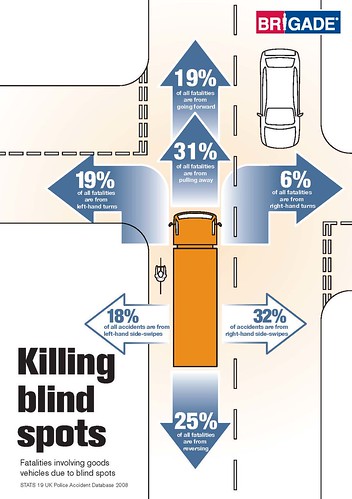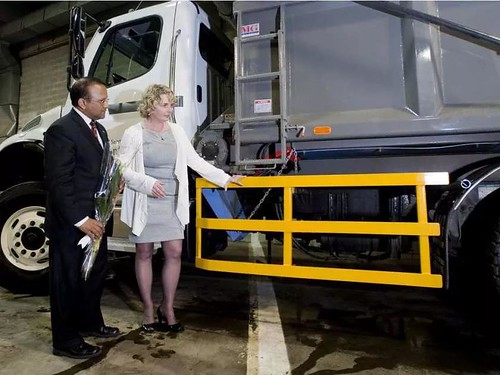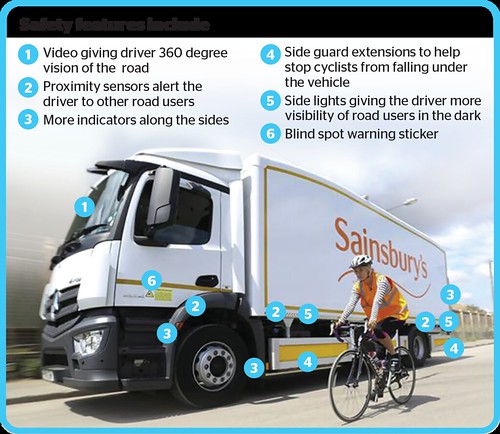Right hook cyclist deaths and a couple tweaks to my ideal Vision Zero agenda
A bicycle is seen underneath the Tomlinson construction truck that collided with a cyclist on Thursday morning. (CBC photo.) The cyclist, Nusrat Jahan, was the 23-year-old daughter of a diplomat and a student at Willis College.
In September, bicyclists were killed in Ottawa, Ontario and Chicago as a result of trucks turning right and running over cyclists.
What killed them is called the "right hook" in bicycle safety planning. It's where a truck turning right hits a cyclist, who is usually present in a "blind spot."
Many if not most cyclist deaths in cities are the result of crashes with trucks and other "heavy vehicles" like buses.

Data on truck-related traffic deaths in 19 UK cities. Graphic by Brigade Electronics, manufacturer of truck camera/vision systems.
This reminded me of various initiatives in London under both Mayor Livingstone and Mayor Johnson. Initiatives including Johnson's the Safer Lorry Scheme, have introduced a number of measures to reduce the likelihood of cyclist death from crashes with lorries.
One of those measures is what are called "safety guards" on the sides of trucks, to prevent cyclists from being crushed by truck wheels ("Cameras on lorries to cut toll of cycle deaths," London Times).

St-Laurent mayor Alan DeSouza and Jeannette Holman-Price attend a news look at a truck side guard on Tuesday, May 8, 2012, after the borough announced details of new safety devices on trucks. Montreal Gazette photo.
In the DC area, most transit systems have special training for bus drivers addressing pedestrian and bicyclist safety. DC government's truck drivers (transportation, public works, water department) have gone through the same training.
There is some irony to the deaths in Chicago because Chicago was just named by Bicycling Magazine as the nation's best city for biking in their annual survey and cover story.
Interestingly, one column in the Citizen ("Cycling dangers mount alongside our growing urban core") suggests that the creation of separated bicycle lanes may create a sense of complacency on the part of bicyclists when it comes safety, which can be problematic when the infrastructure is sub-standard. From the article:
But I’ve come to worry – no, it’s worse than worry, as the skipped heartbeats attest – that segregated lanes and other inducements to pedal around downtown Ottawa are giving cyclists a false sense of security as they boldly slip in and out of the daily rush of inner-city traffic. ...Because Ottawa is the national capital, the local accident has led to calls for the national government to pay closer attention to the issue ("Amid war of words, MP seeks national safe-cycling strategy" and "Feds launch task force on cycling and pedestrian safety") something that used to happen with regard to DC-based events and Congress, but now no longer does, as Congress is increasingly disconnected from addressing issues substantively in most of the issue areas where federal involvement can make a difference. From the latter article:
We should be asking, though, whether incidents like this, which seem to occur in Ottawa now with alarming frequency, and which follow a pretty clear pattern – rush-hour collisions, heavily travelled streets, tight-turn intersections – are not better described as predictable tragedies.
Gareth Davies, president of the Ottawa advocacy group Citizens for Safe Cycling, said he’s “pleasantly surprised” by the momentum in the past week to make safety initiatives a priority.
“It’s good to see the feds doing something,” Davies said.
Transport Minister Marc Garneau announced that the task force will consider cameras, side guards and awareness programs as measures to prevent collisions and reduce injuries and deaths.
Transport Canada will complement the task force’s work by studying technologies to reduce collisions.

Bicycle-related safety improvements for heavy goods vehicles/lorries/trucks, UK
Shockingly compared to the US, the Ottawa truck driver has been charged with serious crimes in association with the crash, where the penalties are as serious as life in prison ("Truck driver charged in Laurier crash that killed cyclist Nusrat Jahan," Citizen). From the article:
Steven Bruce Conley, 38, was charged Friday with criminal negligence causing death and dangerous driving causing death. The dangerous driving charge carries a maximum 14-year sentence upon conviction, while a conviction on criminal negligence causing death can carry a life sentence.By comparison in the US rarely are drivers significantly penalized for traffic accidents resulting in death--unless they are under the influence of alcohol or drugs, or sometimes, in very rare situations of extreme negligence ("Driver to plead guilty to River Road crash that killed 3," WTOP radio).
In the entry "Improvement must be constant," Ottawa's West Side Action blog makes a very good point, that just as we constantly improve the quality of the road infrastructure for motor vehicles, as new infrastructure treatments are developed, we need to do the same for biking, and generally we don't.
In a DC example, more recently, DC's department of transportation has been clarifying bike and motor vehicle movement at intersections, by marking "pocket lanes" for cyclists ("These two new short bike lanes, called "pocket lanes," help traffic flow and keep cyclists safe," Greater Greater Washington).
I've never been to Ottawa, but comments on news articles and blogs indicate that the implementation of the Laurier Avenue cycletrack was suboptimal (hence West Side Action's call for improvements). Note that Toole Design created a best practice guide for cycletracks for the State of Massachusetts, with guidance that is universal.
-- Separated Bike Lane Planning & Design Guide, MassDOT Highway
It was only after advocacy by the London Cycling Campaign that Transport for London improved the design for "Cycle Superhighways," from merely painted lanes to separated lanes ("What did Boris ever do for cycling?").

As enumerated in "Updating vision zero approaches," I aver that the list of 39 items is pretty complete. But I think that adding side guards and cameras to trucks should be added to the section on enforcement and traffic safety engineering. The items are organized into six categories:
- Planning/Placemaking
- Engineering and Maintenance
- Education
- Encouragement
- Enforcement/Traffic Safety Engineering
- Equity
Also, while point 27 asserts that neighborhood streets should be reposted for a 20 mph speed, as is being done in leading cities concerned with rebalancing motor vehicle and placemaking goals, in the interim before such a standard is legislated, it should be standard practice to reduce the speed on streets that are "neighborhood bikeways" to 20 mph, in advance of the general change.
Neighborhood bikeway signage in DC, note the 25 mph speed limit.
Note that earlier this week, Seattle City Council passed legislation to lower speed limits there, including 20 mph for neighborhood streets, and 25 mph for arterials ("Seattle to get lower speed limits" and "Seattle City Council considers lowering speed limits all over the city," Seattle Times).
In the reporting, some argued against the change, finding that tests of lower speed limits in Seattle didn't result in marked changes.
But I would counter that a pilot test on a handful of streets, not a widespread change accompanied by marketing and enforcement of the changes, people's "behavior" with regard to speed won't change.
Furthermore, we don't need to prove changes through pilot tests in each community considering such changes, we can rely on general findings from changes in communities elsewhere
-- "Speed limit reduction in urban areas: a before-after study," Accident Analysis and Prevention
-- "The impact of lowered speed limits in urban and metropolitan areas," Monash University Accident Research Center
======
One other point to add to the section on enforcement and traffic safety engineering that I can't believe I forgot, making front and back lights mandatory equipment on "city/hybrid" type bikes sold for primarily urban use. (And turn signals.)
For example, my criticism of the new Ikea bike, despite its improvements such as belt drive "chain," is that it targets the urban rider but doesn't include lights as "original equipment."
The Breezer Uptown bicycle includes front and rear lights (pictured at left).
Labels: bicycle and pedestrian planning, car culture and automobility, traffic engineering, traffic safety and enforcement, Vision Zero






9 Comments:
Canada's "criminal negligence" statute must be different in design from charges available in the US. e.g.,
https://www.thestar.com/news/crime/2016/09/28/driver-who-ran-red-light-and-killed-cyclist-sentenced-to-2-years-in-jail.html
... Adrian Dudzicki, 23, was cycling to squash practice on the morning he was killed by a driver who recklessly sped through a red light at an intersection in North York.
The now 23-year-old driver, Aleksey Aleksev, was sentenced Wednesday to a jail term of two years less a day, three years of probation and a ban on driving for 15 years.
Hmm, if cyclists are being killed at intersections, how is reducing the speed going to help?
OK, that is just baiting you -- I know VZ is about pedestrians, not cyclists.
But they are being killed at crosswalks as well.
If VZ was more actual harm reduction and not status raising, DC would find a way to photo ticket right turn on red.
Also, Bowser has put a lot of traffic control officers downtown and it working well.
Funny story, I had to entertain some Danes two weeks ago.
I asked them if they tried bikes share. They said riding in the street like they saw was basically suicide.
as you know, from a "Vision Zero" standpoint, DC doesn't have all that many traffic-related deaths. Right hooks likely happen to less experienced cyclists, but I don't know, not having read the various accident analysis reports.
... I was at a party last night where I met a woman whose sister died in a right hook collision with a truck. What do you say ...
one of the big problems with crosswalks is that when a driver stops in one lane because of crossing pedestrians, other drivers in other lanes don't understand that is a cue for stopping as well. It's not a message that's particularly pithy enough for signage.
I find that more of a problem mid-block, one car stops but other cars do not.
As I said, finding a way to automate right on red violations would solve a lot of issues.
The truck ideas are good, I don't see DC or a city being able to enforce them. Given how lax truck safety enforcement here is to start with...
I'm assuming your graphic wold be reversed L-R in the US as the blind spot is on a different side.
example of an unsystematic approach to the issue:
https://www.thestar.com/news/gta/2016/11/19/do-please-slow-down-signs-really-mean-anything-micallef.html
people wanting slow down signs are an indicator of a problem.
What they need is a systematic response. Of course the social marketing signs aren't enough.
- lowering speeds systematically on neighborhood streets
- automated speed cameras
- road materials re-engineering
etc.
2. also Tucson is instituting 20mph on bicycle boulevards
http://tucson.com/news/local/govt-and-politics/road-runner-tucson-bike-boulevard-speed-limit-to-drop-to/article_aaf195da-71d1-5ea8-bc20-b724faec6d46.html
Boston Globe did an interesting analysis of where drunk drivers were likely to have been served to the point of drunkenness.
http://www.bostonglobe.com/business/2016/12/31/the-bars-where-drivers-got-drunk-before-their-oui-arrests/6pJV2qmcYExUz4SLEdPjoI/story.html
and the headline on this piece by Inga Saffron at the Philadelphia Inquirer is particularly apt:
If you want to kill someone and not get punished, use a car
http://www.philly.com/philly/columnists/inga_saffron/If-you-want-to-kill-someone-and-not-get-punished-use-a-car.html
Office Cleaning Services Toronto
Industrial Cleaning Services Toronto
Window Cleaning Services Toronto
Carpet Cleaning Services Toronto
Office Cleaning Services Toronto
Cleaning Services Toronto
Post a Comment
<< Home